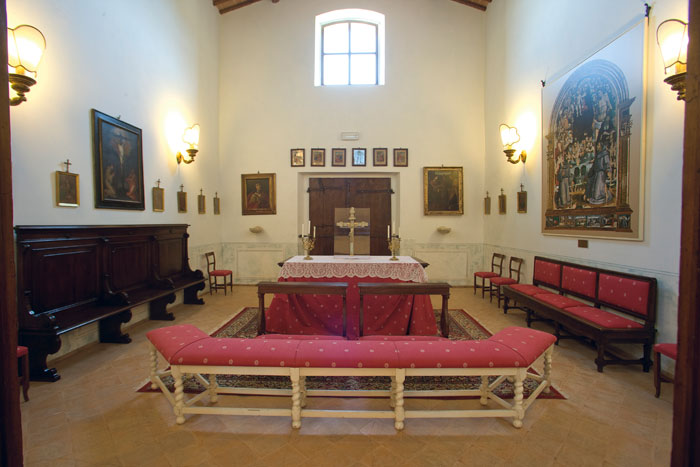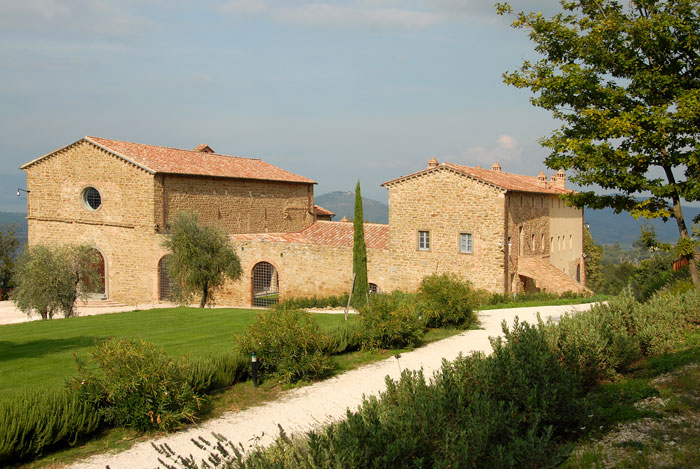History of the farm holidays "I Frati"
The Convent (Il Convento) – 1496
The Convent of Sant’Antonio of Padua Pacciano Vecchio, situated in the diocese of Città della Pieve, dates back to 1496. Its construction was authorised on July 16 that year by Pope Alexander VI, addressing the inhabitants of Pacciano Vecchio and Panicale. He affirmed the importance of this authorization based on the need of the presence of priests who would spread God’s Word and celebrate the Holy Misteries. He therefore gave his permission to build the Convent (“which would have the indulgencies and privileges of all other churches”) with a Church -consecrated to Saint Antonio of Padua- a bell tower, the cemetery, a dormitory, a refectory, a cloister, vegetable gardens and the smithery.
There is a Memorial, found in the Parish Archives of Panicale which says: “The Convent of the Fathers of Sant’Antonio of Paccian Vecchio was founded at the expenses of people from Panicale and Pacciano in 1496, in the site of the prisons of the County of Pacciano Vecchio, granted by the Counts Baglioni”.
On October 12th of the same year, another document was signed by the Convent of the Island in the Trasimeno Lake
In his “Umbria Francescana” (Franciscan Umbria), Father Agostino from Stroncone has summed up the story of the Convent as follows: Filippo Baglioni, Lord and Count of Pacciano Vecchio, let the Chapter of Porziuncola know that he desired a Convent of devotees in the place mentioned, and he offered the site on which the Convent would be built.
Brother Lorenzo Vicario accepted and sent Brother Salvator of Foligno, Brother Graziano, Brother Cherubino, Brother Nicolò and Brother Tadeo from Perugia, who designed the Convent and the Church consecrated to Sant’Antonio.
Brother Franceschino from Gubbio, Brother Angelo from Pacciano, Brother Ginepro from Perugia and Brother Battista from Spello were the witnesses of this creation, and the latter wrote a Memory on October 12, 1496 in the Convent of the Isola Maggiore.
The people of Pacciano and Panicale promoted the building of the Convent at their own expenses. Meanwhile, in August 1497 another interesting document was signed, which reveals the existence of a church in that zone. The Friars of Monteripido in Perugia upheld this document.
On August 11th, the Cardinal Agapito Borgia, Pope Alexander VI’s nephew, approved and confirmed a plea, proposed by the Lesser Brothers of the Convent of Monteripido. Such plea referred to the cession of a uncultivated, stony tree-lined land, as well as the permission to use the stones of the San Salvatore’s Church, located in Cereseto in the diocese of Chiusi but actually bordering on Pacciano Vecchio.

Napoleon’s Decree – 1810
During the French Revolution, the religious orders were suppressed. The Napoleonic decree was issued on April 17th, 1810 and came into effect on April 29th by the Consulta of Roma. The Convent was expropriated on October 15 the same year, and on October 20th the Congregation was impelled to leave.
During this period, Mr. Giuseppe Copella from Panicale and Mr. Paoncelli were left in charge of the Convent. However, after this ordeal, the Convent was opened again by P. Eugenio from Vico on November 18, 1816.
Following the suppression, the Holy Congregation of Bishops and Religious Orders expressed a request to visit every existing convent in the Pontifical State.

The gift offered by the Servi di Maria, residents of Perugia at Porta Eburnea, was estimated at 500 florins by that time, but they gave away everything in the name of God, giving the possibility to the brothers of Pacciano Vecchio of building the new Church.
The building of the Convent and the Church was possible thanks to the efforts of both communities of Pacciano and Panicale. However, since in the 1501 Carlo Ridolfi had conceded a legacy of 100 florins for the altar of Sant’Angelo of Panicale, the frati asked the Pope to get the money back in order to build their Convent. In spite of the objections raised, Pope Alexander VI approved the exchange.
In 1581 the Friars of Pacciano Vecchio obtained the permission to establish the Congregation of Cordigeri, which would always have many followers.
In July 1642, by a decree issued in Rome, this Convent would be referred to as “Pacciano Vecchio” in all public and private acts.
On October 8, 1650 upon request of the Provincial Curia of S. Maria degli Angeli, Brother Giuseppe from Perugia, who was the Father Superior of the Convent, registered the names of all the religious members as well as the debits and credits of the Convent.
The Convent of S. Antonio of Padua of Paccian Vecchio, in the diocese of Città della Pieve, was founded at the expenses of the communities of Pacciano and Panicale, not very far one from another, in 1496.
The illustrious Count Baglioni gave the seat for the building of the Convent, which was afterwards given to the Friars Minor for their devotion to S. Francesco, with no obligation or allocation of founds whatsoever.
In 1767 there was a legal question on an annual legacy of 26 silver coins left by Cristoforo Ranieri in his will in 1607.
With this sum, the Friars would commit to celebrate a mass every day, perpetually. After more than a century, this legacy became too much of a burden for the humble community of Friars. Thanks to a decree of the Holy See, they got the number of masses reduced to 260 a year.
The nephew of the Apostolic Mayor reacted to this, protesting in public, to which there was a legal counter-action based on the laws in force by that time.
The Italian Suppression in 1866
With regard to the religious suppression decreed by the Italian Government in 1866, there is no specific mention in the Records of the Convent.
It is known from other sources, though, that the first decree of expulsion was issued by the High Commissioner of the Government, Gioacchino Pepoli on November 1th, 1860, after the occupation of the regions of Marche and Umbria. Such decree contained a clause which stated that all mendicant friars could remain in their cloisters of residence, provided that they expressed their intention to do so. They then provided to do such request. The definitive decree arrived nonetheless on July 7th, 1866.
Leafing through the Provincial Records in S. Maria degli Angeli, we have found a historic document sent to the General Ministry by the Provincial B. Stefano from Castelplanio, in 1882: “S. Antonio of Paccian Vecchio”, diocese of Città della Pieve – The Friars were expelled from this Convent as well, on March 24th, 1864”. The Church remained closed, and the building as well as its surroundings were rented to third parties.









